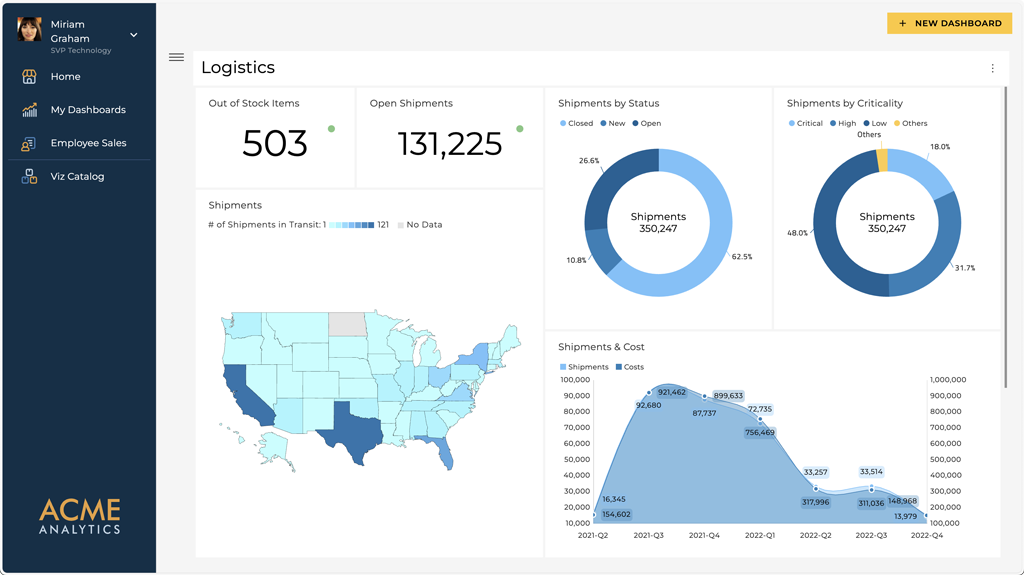
Looker Pros, Cons, and Looker Alternatives
Product leaders need analytics that scale with their app, not retrofitted BI tools. Looker offers strong visualizations and tight Google Cloud integration. But its use of LookML, iFrames, and user-based pricing makes it hard to embed in customer-facing products. As SaaS teams grow, these constraints slow development, increase costs, and limit flexibility. That’s why more teams are replacing Looker with Reveal—an embedded analytics platform built for speed, scale, and predictable pricing. This article breaks down where Looker fits, where it falls short, and why modern SaaS teams are moving on.
Executive Summary:
Key Takeaways:
- Looker delivers strong governance and data visualization, but falls short in terms of providing a seamless embedded UX.
- LookML and iFrames increase complexity, slow delivery, and limit front-end control.
- Performance lags and role-based pricing make scaling costly and unpredictable.
- Best suited for internal dashboards or partner portals where branding isn’t critical.
- SaaS products need SDK-based embedding, real-time analytics, and fixed pricing to grow efficiently.
- Reveal offers full white-label dashboards, native integration, and fast, scalable analytics built for product teams.
As product teams look to deliver data-driven experiences, the demand for in-app analytics has grown. End users want insights that are fast, accessible, and aligned with their daily workflows.
Looker embedded analytics is often considered a go-to option. Its connection to Google Cloud and its established presence in the BI space make it an attractive choice for organizations that already use its ecosystem.
But recognition is not the same as readiness. The real question is how well Looker fits modern product needs. This review examines the pros and cons of Looker, highlighting where it excels and where its limitations begin to slow down SaaS and enterprise applications.
Is Looker Embedded Built for Your Product Architecture?
Looker embedded analytics brings a strong reputation in BI, but its architecture was not designed with product teams in mind. The platform is built around LookML, a proprietary modeling language that defines metrics and relationships. While powerful, this adds a steep learning curve and makes embedding analytics dependent on skills that many product teams lack. For SaaS leaders, this translates into extra ramp-up time and increased reliance on specialized staff.
Most embedded BI platforms now focus on developer-first integration. Looker, by contrast, depends heavily on iFrames for embedding. Teams must manage signed URLs, authentication flows, and session handoffs to deliver dashboards inside their apps. This setup limits how much control you have over the user experience. Styling, responsiveness, and event handling all remain tied to Looker’s framework, not your product’s.
These architectural choices become bigger hurdles in multi-tenant architectures and cloud-native applications. Serving dashboards to multiple customers requires extra configuration, and scaling workloads often triggers performance tuning. Developers also face limits in creating custom interactions or extending analytics to align with product workflows. Looker works well for traditional reporting, but its technical foundation can slow down teams that want analytics to feel native, flexible, and scalable.

Pros: What Looker Embedded Analytics Does Well
While a review of Looker’s pros and cons highlights some limitations, the platform does bring real strengths. These advantages explain why it remains a common choice for enterprises seeking analytics tools.
Key pros of Looker embedded analytics:
- Intuitive interface: Users find Looker’s design accessible, making it easier for non-technical users to interact with dashboards.
- Strong data visualization: The platform delivers polished, interactive dashboards that help teams share insights with clarity.
- Extensive integrations: Looker connects to a wide range of databases, cloud tools, and CRMs, supporting broad reporting needs.
- Semantic modeling with LookML: Centralized modeling ensures consistency across reports, keeping business logic aligned.
- Enterprise security and governance: Role-based dashboards, permissions, and integration with Google Cloud’s security framework support enterprise requirements.
These strengths give Looker an edge in environments where governance, data visualization, and centralized reporting matter most. For organizations already tied into Google Cloud, its integrations provide a straightforward way to extend analytics.
Cons: Key Challenges with Looker Embedded Analytics
While Looker’s embedded analytics offer strong features, users and product teams often encounter challenges that impact long-term fit. These issues explain why many teams begin evaluating Looker alternatives.
Key cons of Looker embedded analytics:
- Steep learning curve and LookML dependency: Success with Looker depends on mastering LookML, a proprietary modeling language. This slows onboarding and creates barriers for teams without that expertise.
- Performance slowdowns at scale: Users report slow dashboards with large datasets or many visual elements. Scaling workloads often requires ongoing performance tuning.
- Embedding complexity and iFrame limitations: Looker relies heavily on iFrames, signed URLs, and session management. This makes integration complex and limits customization.
- Pricing complexity and user-based growth: Quote-based pricing tied to roles and seats grows quickly as adoption expands, making costs unpredictable.
- Limited white-label control: By default, embedded dashboards carry Looker branding. Deeper customization requires admin settings or additional licensing, leaving UI integration incomplete.
These drawbacks become more visible in SaaS environments that require scalable analytics, developer-friendly integration, and white-label dashboards that feel native. For fast-moving teams, the overhead of learning LookML, managing iFrames, and predicting costs can hinder delivery speed and reduce user satisfaction.
When Looker Embedded May Be a Good Fit
While Looker has its noticeable limitations, there are still specific cases when Looker Embedded can suffice. For products with certain priorities and established practices, Looker can still offer adequate value.
Looker may fit your product if:
- Google Cloud Alignment: Organizations already using BigQuery and GCP services may benefit from native integration.
- Internal or partner portals: Works best when dashboards serve employees or trusted partners, not customer-facing apps.
- Centralized reporting needs: Ideal when governance, compliance, and consistent data visualization are more important than deep customization.
- Familiar workflows: Teams already trained in LookML may prefer to continue within the same ecosystem.
- Limited branding requirements: When visual consistency with the product UI is not critical, Looker’s default design can suffice.
In these use cases, Looker can be a workable option. But when analytics must feel fully native, support complex workflows, or scale predictably, many teams begin comparing BI alternatives that better align with modern product demands.
When to Consider a Looker Alternative
Looker solves certain reporting needs, but SaaS and ISV teams often find its design limiting when analytics must live inside the product. As these limits pile up, exploring Looker alternatives becomes less of an option and more of a necessity.
Key triggers that signal it’s time to evaluate alternatives:
- Analytics is customer-facing: Users expect dashboards to feel like part of your app. With Looker, embedding relies on iFrames that often look disconnected. This breaks the seamless product experience and reduces adoption. Teams need embedded analytics that behave like a built-in feature.
- Scalability matters: SaaS companies scale quickly. With Looker, performance issues surface when datasets grow or tenants multiply. Queries slow down, and optimization becomes ongoing overhead. Modern scalable analytics must deliver consistent speed and reliability across large data volumes and multi-tenant environments.
- Customization drives value: Customers want analytics aligned with their workflows. Looker provides limited customization beyond its defaults. Advanced features often require heavy LookML coding or workaround scripts. Teams benefit more from API-first integration and SDK-based tools that let them build features and workflows unique to their product.
- Costs must stay predictable: Looker uses role- or user-based pricing. This works for small deployments, but as adoption grows, costs can climb quickly and unpredictably. Forecasting long-term budgets becomes difficult. Many teams seek alternatives that provide pricing transparency and stable cost structures.
- Branding must be seamless: Looker embeds carry its branding by default, with deeper customization requiring extra steps or licenses. This creates a disjointed look that undermines the product experience. Teams that need white-label dashboards to reflect their brand often turn to other options.
These issues rarely appear on day one. But as usage expands, the friction grows and slows innovation. For many SaaS leaders, this turning point is when alternatives to Looker, built for product embedding become the logical next step.
How Reveal Compares as a Looker Alternative
Teams exploring Looker alternatives often want analytics that feel native, perform at scale, and come with predictable costs. While Looker embedded analytics supports BI reporting, its structure makes it harder to align with SaaS product demands. Reveal was created for that exact scenario—embedding analytics inside software products.

With Reveal, developers embed dashboards using a JavaScript client library compatible with Angular, React, Blazor, Vue, and more, plus server packages for .NET Core, NodeJS, and Java.
This approach provides full control over the user interface through API-first integration, allowing dashboards to match the product experience instead of being confined to an external frame. The result is analytics that looks and behaves as if it were built in-house.
Performance is equally important. Reveal delivers real-time analytics designed for large datasets and multi-tenant SaaS environments. Dashboards load quickly, scale with demand, and remain responsive across users. This ensures teams can serve analytics without slowing down growth or complicating infrastructure.
Costs also stay predictable. Instead of tying pricing to users or roles, Reveal offers pricing transparency with a single fixed structure. Teams can grow adoption without worrying about rising bills, which makes planning straightforward.
Branding control comes built in. Reveal offers white-label dashboards that precisely replicate product themes and layouts, resulting in a seamless look and feel. You can see more details in Reveal’s approach to white-label analytics.
For SaaS leaders comparing Looker alternatives, Reveal provides a developer-ready platform that combines flexibility, performance, and cost predictability. Learn more about Reveal’s embedded analytics or explore a detailed Reveal vs. Looker breakdown. If you want a practical next step, try the free Embedded BI Features Checklist.


 Return to Blog
Return to Blog


